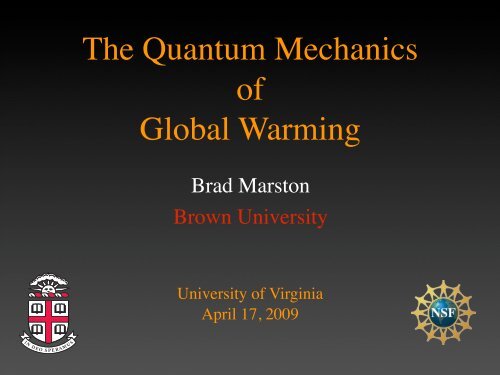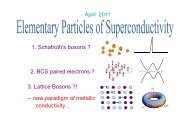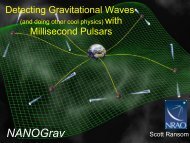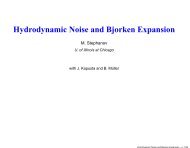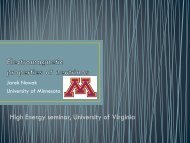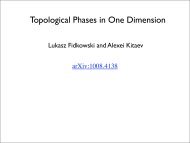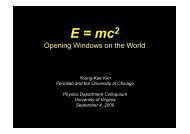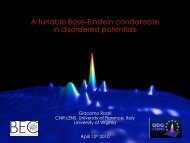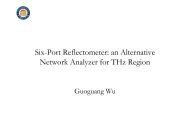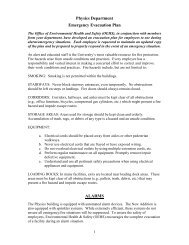The Quantum Mechanics of Global Warming - University of Virginia
The Quantum Mechanics of Global Warming - University of Virginia
The Quantum Mechanics of Global Warming - University of Virginia
Create successful ePaper yourself
Turn your PDF publications into a flip-book with our unique Google optimized e-Paper software.
<strong>The</strong> <strong>Quantum</strong> <strong>Mechanics</strong><br />
<strong>of</strong><br />
<strong>Global</strong> <strong>Warming</strong><br />
Brad Marston<br />
Brown <strong>University</strong><br />
<strong>University</strong> <strong>of</strong> <strong>Virginia</strong><br />
April 17, 2009
Richardson’s Human Weather Computer (1917 --1922)<br />
“Lewis Fry Richardson’s imaginary `forecast factor’ would have employed some 64,000 human<br />
computers to keep up with the pace <strong>of</strong> the weather, <strong>The</strong> workers sit in tiers inside a great<br />
spherical theater; the director, atop a pedestal in the middle, shines a beam <strong>of</strong> light on those<br />
places where the calculation is getting ahead or falling behind.” [Brian Hayes, American Scientist<br />
80, 10 -- 14 (2001).]
cooler sun<br />
continental drift<br />
orogeny<br />
climate<br />
optimum<br />
LIA<br />
synoptic<br />
disturbances
Outline
Outline<br />
• <strong>Quantum</strong> <strong>Mechanics</strong> #1: blackbody radiation
Outline<br />
• <strong>Quantum</strong> <strong>Mechanics</strong> #1: blackbody radiation<br />
• QM #2: Why we aren’t freezing
Outline<br />
• <strong>Quantum</strong> <strong>Mechanics</strong> #1: blackbody radiation<br />
• QM #2: Why we aren’t freezing<br />
• QM #3: Deciphering ice and sediment records
Outline<br />
• <strong>Quantum</strong> <strong>Mechanics</strong> #1: blackbody radiation<br />
• QM #2: Why we aren’t freezing<br />
• QM #3: Deciphering ice and sediment records<br />
• Fluid Dynamics: Single layer models<br />
• Coriolis Force<br />
• Stratification & Differential Heating<br />
• Topography
Outline<br />
• <strong>Quantum</strong> <strong>Mechanics</strong> #1: blackbody radiation<br />
• QM #2: Why we aren’t freezing<br />
• QM #3: Deciphering ice and sediment records<br />
• Fluid Dynamics: Single layer models<br />
• Coriolis Force<br />
• Stratification & Differential Heating<br />
• Topography<br />
• <strong>Quantum</strong> field theory <strong>of</strong> global warming?
Outline<br />
• <strong>Quantum</strong> <strong>Mechanics</strong> #1: blackbody radiation<br />
• QM #2: Why we aren’t freezing<br />
• QM #3: Deciphering ice and sediment records<br />
• Fluid Dynamics: Single layer models<br />
• Coriolis Force<br />
• Stratification & Differential Heating<br />
• Topography<br />
• <strong>Quantum</strong> field theory <strong>of</strong> global warming?<br />
• Ecosystems and feedbacks
Crisis in 19th Century Classical Physics
Crisis in 19th Century Classical Physics<br />
Intensity = function(T emperature, frequency)
Crisis in 19th Century Classical Physics<br />
Intensity = function(T emperature, frequency)<br />
[I] = W atts<br />
meter 2 = Joules<br />
m 2 s
Crisis in 19th Century Classical Physics<br />
Intensity = function(T emperature, frequency)<br />
[I] = W atts<br />
meter 2 = Joules<br />
m 2 s<br />
[k B T ] = J
Crisis in 19th Century Classical Physics<br />
Intensity = function(T emperature, frequency)<br />
[I] = W atts<br />
meter 2 = Joules<br />
m 2 s<br />
[k B T ] = J [ν] = 1 s
Crisis in 19th Century Classical Physics<br />
Intensity = function(T emperature, frequency)<br />
[I] = W atts<br />
meter 2 = Joules<br />
m 2 s<br />
[k B T ] = J [ν] = 1 s<br />
c = 3 × 10 8 m/s speed <strong>of</strong> light<br />
k B = 1.38 × 10 −23 J/K Boltzmann ′ s constant
Crisis in 19th Century Classical Physics<br />
Intensity = function(T emperature, frequency)<br />
[I] = W atts<br />
meter 2 = Joules<br />
m 2 s<br />
[k B T ] = J [ν] = 1 s<br />
c = 3 × 10 8 m/s speed <strong>of</strong> light<br />
k B = 1.38 × 10 −23 J/K Boltzmann ′ s constant<br />
∆I(T, ν) ∝ k BT ν 2<br />
∆ν<br />
c 2
Crisis in 19th Century Classical Physics<br />
Intensity = function(T emperature, frequency)<br />
[I] = W atts<br />
meter 2 = Joules<br />
m 2 s<br />
[k B T ] = J [ν] = 1 s<br />
c = 3 × 10 8 m/s speed <strong>of</strong> light<br />
k B = 1.38 × 10 −23 J/K Boltzmann ′ s constant<br />
∆I(T, ν) ∝ k BT ν 2<br />
c 2 ∆ν I =<br />
∞∑<br />
∆I(T, ν) → ∞<br />
ν=0
Crisis in 19th Century Classical Physics<br />
Intensity = function(T emperature, frequency)<br />
[I] = W atts<br />
meter 2 = Joules<br />
m 2 s<br />
[k B T ] = J [ν] = 1 s<br />
c = 3 × 10 8 m/s speed <strong>of</strong> light<br />
k B = 1.38 × 10 −23 J/K Boltzmann ′ s constant<br />
∆I(T, ν) ∝ k BT ν 2<br />
c 2 ∆ν I =<br />
∞∑<br />
∆I(T, ν) → ∞<br />
ν=0<br />
UV Catastrophe!
<strong>The</strong> Solution: Quanta
<strong>The</strong> Solution: Quanta<br />
Light is composed <strong>of</strong><br />
particles -- quanta --<br />
called photons.<br />
ɛ = hν Photons carry energy.<br />
h = 6.63 × 10 −34 Js Planck ′ s constant
<strong>The</strong> Solution: Quanta<br />
Light is composed <strong>of</strong><br />
particles -- quanta --<br />
called photons.<br />
ɛ = hν Photons carry energy.<br />
h = 6.63 × 10 −34 Js Planck ′ s constant<br />
New constant <strong>of</strong><br />
nature makes it<br />
possible to write<br />
the correct intensity.<br />
∆I(T, ν) = 2πhν3<br />
c 2 1<br />
e hν/k BT<br />
− 1 ∆ν<br />
→ 2πk BTν 2<br />
→<br />
c 2<br />
0 for ν →∞<br />
∆ν for k B T ≫ hν
<strong>The</strong> Solution: Quanta<br />
Light is composed <strong>of</strong><br />
particles -- quanta --<br />
called photons.<br />
ɛ = hν Photons carry energy.<br />
h = 6.63 × 10 −34 Js Planck ′ s constant<br />
New constant <strong>of</strong><br />
nature makes it<br />
possible to write<br />
the correct intensity.<br />
∆I(T, ν) = 2πhν3<br />
c 2 1<br />
e hν/k BT<br />
− 1 ∆ν<br />
→ 2πk BTν 2<br />
→<br />
c 2<br />
0 for ν →∞<br />
∆ν for k B T ≫ hν<br />
Now we can<br />
do that sum<br />
over frequency!<br />
I = σT 4<br />
σ ≡ 2π5 kB<br />
4 W<br />
15h 3 =5.67 × 10−8<br />
c2 m 2 K 4
∆I(T, ν) = 2πhν3<br />
c 2 1<br />
e hν/k BT<br />
− 1 ∆ν<br />
→ 2πk BTν 2<br />
→<br />
c 2<br />
0 for ν →∞<br />
∆ν for k B T ≫ hν<br />
Agree to better than<br />
1 part in 100,000
Temperature <strong>of</strong> the Earth<br />
Rsun<br />
<strong>The</strong> earth is (almost) in a thermal<br />
steady state: it emits as much radiation<br />
as it receives from the sun.<br />
r E<br />
RE
Temperature <strong>of</strong> the Earth<br />
Rsun<br />
<strong>The</strong> earth is (almost) in a thermal<br />
steady state: it emits as much radiation<br />
as it receives from the sun.<br />
r E<br />
Albedo = a = 30%visible light<br />
reflected directly back to space<br />
(“earthshine” on the new moon).<br />
RE
Temperature <strong>of</strong> the Earth<br />
Rsun<br />
<strong>The</strong> earth is (almost) in a thermal<br />
steady state: it emits as much radiation<br />
as it receives from the sun.<br />
r E<br />
Albedo = a = 30%visible light<br />
reflected directly back to space<br />
(“earthshine” on the new moon).<br />
fraction = πR2 E<br />
4πr 2 E<br />
× (1 − a)<br />
RE
Energy Balance<br />
Luminosity = Area × Intensity<br />
= 4πR 2 sun × σT 4 sun
Energy Balance<br />
Luminosity = Area × Intensity<br />
= 4πR 2 sun × σT 4 sun<br />
incoming<br />
energy flux
Energy Balance<br />
Luminosity = Area × Intensity<br />
= 4πR 2 sun × σT 4 sun<br />
incoming<br />
energy flux<br />
πR 2 E<br />
4πr 2 E<br />
(1 − a) 4πR 2 sun σT 4 sun = 4πR 2 E σT 4 E
Energy Balance<br />
Luminosity = Area × Intensity<br />
= 4πR 2 sun × σT 4 sun<br />
Space<br />
incoming<br />
energy flux<br />
outgoing<br />
energy flux (IR)<br />
πR 2 E<br />
4πr 2 E<br />
(1 − a) 4πR 2 sun σT 4 sun = 4πR 2 E σT 4 E
Energy Balance<br />
Luminosity = Area × Intensity<br />
= 4πR 2 sun × σT 4 sun<br />
Space<br />
incoming<br />
energy flux<br />
outgoing<br />
energy flux (IR)<br />
πR 2 E<br />
4πr 2 E<br />
(1 − a) 4πR 2 sun σT 4 sun = 4πR 2 E σT 4 E
Energy Balance<br />
Luminosity = Area × Intensity<br />
= 4πR 2 sun × σT 4 sun<br />
Space<br />
incoming<br />
energy flux<br />
outgoing<br />
energy flux (IR)<br />
πR 2 E<br />
4πr 2 E<br />
(1 − a) 4πR 2 sun σT 4 sun = 4πR 2 E σT 4 E<br />
r E = 150 × 10 9 m<br />
R sun = 6.96 × 10 8 m<br />
T sun = 5, 800K
Energy Balance<br />
Luminosity = Area × Intensity<br />
incoming<br />
energy flux<br />
= 4πR 2 sun × σT 4 sun<br />
Space<br />
outgoing<br />
energy flux (IR)<br />
πR 2 E<br />
4πr 2 E<br />
(1 − a) 4πR 2 sun σT 4 sun = 4πR 2 E σT 4 E<br />
r E = 150 × 10 9 m<br />
R sun = 6.96 × 10 8 m<br />
T sun = 5, 800K<br />
√<br />
T E = (1 − a) 1/4 Rsun<br />
2r E<br />
≈ 251K = −22C<br />
T sun
Energy Balance<br />
Luminosity = Area × Intensity<br />
incoming<br />
energy flux<br />
= 4πR 2 sun × σT 4 sun<br />
Space<br />
outgoing<br />
energy flux (IR)<br />
πR 2 E<br />
4πr 2 E<br />
(1 − a) 4πR 2 sun σT 4 sun = 4πR 2 E σT 4 E<br />
r E = 150 × 10 9 m<br />
R sun = 6.96 × 10 8 m<br />
T sun = 5, 800K<br />
√<br />
T E = (1 − a) 1/4 Rsun<br />
2r E<br />
≈ 251K = −22C<br />
T sun<br />
FREEZING
Terrestrial Planets
Planet Earth Mars Venus<br />
calculated<br />
temperature<br />
actual<br />
temperature<br />
-18 0 C -56 0 C -39 0 C<br />
15 0 C -53 0 C 427 0 C<br />
greenhouse<br />
warming 33 0 C 3 0 C 466 0 C
Planet Earth Mars Venus<br />
calculated<br />
temperature<br />
actual<br />
temperature<br />
-18 0 C -56 0 C -39 0 C<br />
15 0 C -53 0 C 427 0 C<br />
greenhouse<br />
warming 33 0 C 3 0 C 466 0 C
Planet Earth Mars Venus<br />
calculated<br />
temperature<br />
actual<br />
temperature<br />
-18 0 C -56 0 C -39 0 C<br />
15 0 C -53 0 C 427 0 C<br />
greenhouse<br />
warming 33 0 C 3 0 C 466 0 C
Planet Earth Mars Venus<br />
calculated<br />
temperature<br />
actual<br />
temperature<br />
-18 0 C -56 0 C -39 0 C<br />
15 0 C -53 0 C 427 0 C<br />
greenhouse<br />
warming 33 0 C 3 0 C 466 0 C<br />
Water Vapour: 65% Carbon Dioxide: 21%
Why We Aren’t Freezing<br />
from Climate Change 1995: <strong>The</strong> Science <strong>of</strong> Climate Change
H2O<br />
hν<br />
-<br />
+ +<br />
hν<br />
hν = Ef - Ei
H2O<br />
hν<br />
-<br />
+ +<br />
hν<br />
hν = Ef - Ei<br />
CO2<br />
- +<br />
-
H2O<br />
hν<br />
-<br />
+ +<br />
hν<br />
hν = Ef - Ei<br />
CO2<br />
N2<br />
O2<br />
Ar<br />
- +<br />
-<br />
Transparent
Principal greenhouse<br />
gas: water vapor<br />
Secondary: carbon<br />
dioxide, methane,<br />
CFC’s, …<br />
Robert A. Rohde for the <strong>Global</strong> <strong>Warming</strong> Art project
Principal greenhouse<br />
gas: water vapor<br />
Secondary: carbon<br />
dioxide, methane,<br />
CFC’s, …<br />
Absorption lines are<br />
pressure-broadened<br />
Robert A. Rohde for the <strong>Global</strong> <strong>Warming</strong> Art project
Principal greenhouse<br />
gas: water vapor<br />
Secondary: carbon<br />
dioxide, methane,<br />
CFC’s, …<br />
Absorption lines are<br />
pressure-broadened<br />
IR photons are on<br />
average absorbed and<br />
emitted about 2x on<br />
way out to space<br />
Robert A. Rohde for the <strong>Global</strong> <strong>Warming</strong> Art project
John Harte, Consider a Spherical Cow
Ω = 1372 W/m 2<br />
John Harte, Consider a Spherical Cow
John Harte, Consider a Spherical Cow<br />
Ω = 1372 W/m 2 Ω<br />
4<br />
= a Ω 4 + σT 4 0 + F w<br />
2σT 4 0 = σT 4 1 + 0.5F e + 0.7F s<br />
2σT 4 1 = σT 4 0 + σT 4 s − F w + F c + 0.5F e + 0.3F s
John Harte, Consider a Spherical Cow<br />
Ω = 1372 W/m 2 Ω<br />
4<br />
= a Ω 4 + σT 4 0 + F w<br />
2σT0 4 = σT1 4 + 0.5F e + 0.7F s<br />
2σT1 4 = σT0 4 + σTs 4 − F w + F c + 0.5F e + 0.3F s<br />
F s ≈ 86 W/m 2 Solar flux absorbed by atmosphere<br />
F e ≈ 80 W/m 2 Latent heat from evaporating water<br />
F w ≈ 20 W/m 2 IR flux directly to space<br />
F c ≈ 17 W/m 2 Convective heat transfer
John Harte, Consider a Spherical Cow<br />
Ω = 1372 W/m 2 Ω<br />
4<br />
= a Ω 4 + σT 4 0 + F w<br />
2σT 4 0 = σT 4 1 + 0.5F e + 0.7F s<br />
2σT1 4 = σT0 4 + σTs 4 − F w + F c + 0.5F e + 0.3F s<br />
T<br />
F s ≈ 86 W/m 2 0 = 250K<br />
Solar flux absorbed by atmosphere<br />
T<br />
F e ≈ 80 W/m 2 1 = 278K<br />
Latent heat from evaporating water<br />
T<br />
F w ≈ 20 W/m 2 s = 289K = 16C<br />
IR flux directly to space<br />
F c ≈ 17 W/m 2 Convective heat transfer<br />
Excellent agreement<br />
for such a simple model
Tropopause<br />
Z e Z e + !Z e<br />
Held & Soden (2000)<br />
Altitude<br />
1xCO 2<br />
2xCO 2<br />
Temperature<br />
T e<br />
T s<br />
T s + !T s<br />
Figure 1 Schematic illustration <strong>of</strong> the change in emission level (Z e ) associated with an<br />
increase in surface temperature (T s ) due to a doubling <strong>of</strong> CO 2 assuming a fixed atmospheric<br />
lapse rate. Note that the effective emission temperature (T e ) remains unchanged.
<strong>The</strong> Past 160,000 Years<br />
J. M. Barnola et al., Nature 329, 408 (1987)<br />
Carbon Dioxide<br />
Temperature<br />
Present
<strong>Quantum</strong> Zero-Point Motion<br />
(Harold Urey, “<strong>The</strong> thermodynamic properties <strong>of</strong> isotopic substances,” 1946)
<strong>Quantum</strong> Zero-Point Motion<br />
Classically: All motion ceases at absolute zero temperature.<br />
Everything freezes into a solid.<br />
(Harold Urey, “<strong>The</strong> thermodynamic properties <strong>of</strong> isotopic substances,” 1946)
<strong>Quantum</strong> Zero-Point Motion<br />
Classically: All motion ceases at absolute zero temperature.<br />
Everything freezes into a solid.<br />
<strong>Quantum</strong> physics: <strong>The</strong>re is still some motion even at T = 0.<br />
This is why liquid helium never freezes!<br />
(Harold Urey, “<strong>The</strong> thermodynamic properties <strong>of</strong> isotopic substances,” 1946)
<strong>Quantum</strong> Zero-Point Motion<br />
Classically: All motion ceases at absolute zero temperature.<br />
Everything freezes into a solid.<br />
<strong>Quantum</strong> physics: <strong>The</strong>re is still some motion even at T = 0.<br />
This is why liquid helium never freezes!<br />
Small mass --> large<br />
quantum zero-point<br />
motion and energy.<br />
ν = 1<br />
2π<br />
√<br />
2k<br />
m<br />
E 0 = 1 2 hν<br />
m<br />
k<br />
m<br />
He<br />
(Harold Urey, “<strong>The</strong> thermodynamic properties <strong>of</strong> isotopic substances,” 1946)
<strong>Quantum</strong> Zero-Point Motion<br />
Classically: All motion ceases at absolute zero temperature.<br />
Everything freezes into a solid.<br />
<strong>Quantum</strong> physics: <strong>The</strong>re is still some motion even at T = 0.<br />
This is why liquid helium never freezes!<br />
Small mass --> large<br />
quantum zero-point<br />
motion and energy.<br />
ν = 1<br />
2π<br />
√<br />
2k<br />
m<br />
E 0 = 1 2 hν<br />
m<br />
k<br />
m<br />
He<br />
18O versus 16O in H2O: Classically both molecules have same energy.<br />
<strong>Quantum</strong> zero-point energy means that 18O water is slightly less likely<br />
to evaporate during cold spells.<br />
(Harold Urey, “<strong>The</strong> thermodynamic properties <strong>of</strong> isotopic substances,” 1946)
S. J. Johnsen et al. Tellus 41B, 452 (1989)
Eccentricity: 100 and 413 kyr<br />
N<br />
S
α Draconis<br />
(2000 BC)<br />
Polaris<br />
(now)<br />
Precession: 19 to 23 kyr<br />
Eccentricity: 100 and 413 kyr<br />
N<br />
S
α Draconis<br />
(2000 BC)<br />
Polaris<br />
(now)<br />
Precession: 19 to 23 kyr<br />
Eccentricity: 100 and 413 kyr<br />
N<br />
23.5o (now)<br />
ecliptic<br />
S<br />
Change in tilt <strong>of</strong> axis<br />
“obliquity”: 41 kyr
Spectral Analysis <strong>of</strong> Isotope Records<br />
Figures from Ice Ages and<br />
Astronomical Causes: Data,<br />
Spectral Analysis, and Mechanisms<br />
by R. Muller and G. MacDonald
Spectral Analysis <strong>of</strong> Isotope Records<br />
Figures from Ice Ages and<br />
Astronomical Causes: Data,<br />
Spectral Analysis, and Mechanisms<br />
by R. Muller and G. MacDonald
What amplifies orbital<br />
forcing to produce<br />
ice ages?
What amplifies orbital<br />
forcing to produce<br />
ice ages?<br />
Why does 100 kyr<br />
eccentricity period<br />
dominate climate signal?
What amplifies orbital<br />
forcing to produce<br />
ice ages?<br />
Why does 100 kyr<br />
eccentricity period<br />
dominate climate signal?<br />
Why did the 41 kyr<br />
period dominate 1.5<br />
million years ago?
Martian Climate May Also<br />
Show Orbital Forcing<br />
North Polar Cap <strong>of</strong> Mars<br />
Laskar, Levrard, and Mustard,<br />
Nature 419, 375 (2002); Head<br />
et al. Nature 426, 797 (2003).
D. Lüthi et al. Nature 453, 379 (2008)<br />
26
LIDE 7<br />
Ice Age Climate Forcings (W/m 2 )<br />
aerosols<br />
greenhouse<br />
ice sheets gases<br />
&<br />
vegetation CO 2<br />
-0.5 ± 1<br />
CH 4<br />
N 2 O<br />
-2.6 ± 0.5<br />
-3.5 ± 1<br />
Fig 2. <strong>Global</strong> radiative forcings during the last ice age relative to the current<br />
interglacial period. <strong>The</strong> total forcing is -6.6 ± 1.5 W/m 2 . Thus, the 5°C cooling<br />
<strong>of</strong> the ice age implies a climate sensitivity <strong>of</strong> 0.75°C per 1 W/m 2 forcing.<br />
Hansen, J. et al., <strong>The</strong> missing climate forcing, Phil. Trans. R. Soc. London. B, 352, 231-240, 1997.
Atmospheric Dynamics<br />
from Climate Change 1995:<br />
<strong>The</strong> Science <strong>of</strong> Climate Change
Single Layer Models
Single Layer Models<br />
Dω<br />
Dt =0
Single Layer Models<br />
Vorticity<br />
Dω<br />
Dt =0<br />
ω = ˆr · ( ⃗ ∇×⃗v)
Single Layer Models<br />
Vorticity<br />
Dω<br />
Dt =0<br />
ω = ˆr · ( ⃗ ∇×⃗v)<br />
∂ω<br />
∂t + ⃗v · ⃗∇ω =0<br />
⃗v = ˆr × ⃗ ∇ψ<br />
⃗∇· ⃗v = 0<br />
ω = ∇ 2 ψ
Single Layer Models<br />
Vorticity<br />
Dω<br />
Dt =0<br />
ω = ˆr · ( ⃗ ∇×⃗v)<br />
∂ω<br />
∂t + ⃗v · ⃗∇ω =0<br />
∂ω<br />
∂t<br />
+ J(ψ, ω) = 0<br />
⃗v = ˆr × ⃗ ∇ψ<br />
⃗∇· ⃗v = 0<br />
J(ψ, ω) ≡ ∂ψ<br />
∂x<br />
∂ω<br />
∂y − ∂ψ<br />
∂y<br />
∂ω<br />
∂x<br />
ω = ∇ 2 ψ
Freely Decaying Turbulence<br />
on Sphere
Coriolis Force
Coriolis Force<br />
∂q<br />
∂t<br />
+ J(ψ, q) = 0
Coriolis Force<br />
∂q<br />
∂t<br />
+ J(ψ, q) = 0<br />
Relative vorticity<br />
q = ω + f<br />
Coriolis term<br />
Absolute<br />
vorticity<br />
= ∇ 2 ψ + f
Coriolis Force<br />
∂q<br />
∂t<br />
+ J(ψ, q) = 0<br />
Relative vorticity<br />
q = ω + f<br />
Coriolis term<br />
Absolute<br />
vorticity<br />
= ∇ 2 ψ + f<br />
f = 2Ω sin(φ)
Coriolis Force
Chelton et al., Science 303, 978 (2004)
Stratification
Stratification<br />
q = ∇ 2 ψ + f − ψ l 2 R
Stratification<br />
q = ∇ 2 ψ + f − ψ l 2 R<br />
l 2 R = gh<br />
f 2
Stratification<br />
q = ∇ 2 ψ + f − ψ l 2 R<br />
l 2 R = gh<br />
f 2<br />
h<br />
l R = O(1, 000 km)
Stratification Sets Synoptic Length<br />
Scale
Stratification Sets Synoptic Length<br />
Scale
7. <strong>The</strong> NADW Meridional Cell and Deep Western Boundary Current<br />
b -,c.<br />
Q. '"<br />
=~ ,,-a<br />
Figure 1-91 : A new version <strong>of</strong><br />
Figure 1-90 with schematic<br />
meridional sections <strong>of</strong><br />
interbasin flow for each ocean<br />
with their global linkages.<br />
SAMW<br />
AAIW<br />
RSOW<br />
AABW<br />
NPDW<br />
AAC<br />
CDW<br />
NADW<br />
UPPER IW<br />
IODW<br />
Subantarctic Mode Water<br />
Antarctic Intermediate Water<br />
Red Sea Overflow Water<br />
Antarctic Bottom Water<br />
North Pacific Deep Water<br />
Antarctic Circumpolar Current<br />
Circumpolar Deep Water<br />
North Atlantic Deep Water<br />
26.8:: (Je:: 27.25<br />
Indian Ocean Deep Water<br />
W. J. Schmitz, WHOI technical report 96-03<br />
<strong>The</strong>re is a recent review article on NADW (Fine, 1995) containing a schematic
City Latitude January ( o F) August ( o F)<br />
Glasgow 56 o 34 to 45 52 to 64<br />
Sitka 57 o 30 to 38 52 to 62
City Latitude January ( o F) August ( o F)<br />
Glasgow 56 o 34 to 45 52 to 64<br />
Sitka 57 o 30 to 38 52 to 62
City Latitude January ( o F) August ( o F)<br />
Glasgow 56 o 34 to 45 52 to 64<br />
Sitka 57 o 30 to 38 52 to 62
Topography & Angular Momentum<br />
Richard Seager, “<strong>The</strong> Source <strong>of</strong> Europe’s Mild<br />
Climate,” American Scientist (July-August 2006)
<strong>Quantum</strong> Field <strong>The</strong>ory<br />
<strong>of</strong> <strong>Global</strong> <strong>Warming</strong>?<br />
"More than any other theoretical procedure,<br />
numerical integration is also subject to the criticism<br />
that it yields little insight into the problem. <strong>The</strong><br />
computed numbers are not only processed like data<br />
but they look like data, and a study <strong>of</strong> them may be<br />
no more enlightening than a study <strong>of</strong> real<br />
meteorological observations. An alternative<br />
procedure which does not suffer this disadvantage<br />
consists <strong>of</strong> deriving a new system <strong>of</strong> equations<br />
whose unknowns are the statistics themselves."<br />
Edward Lorenz, <strong>The</strong> Nature and <strong>The</strong>ory <strong>of</strong> the General Circulation (1967)
PV = nRT
PV = nRT<br />
<strong>The</strong>rmodynamics vs. Statistical <strong>Mechanics</strong>
PV = nRT<br />
<strong>The</strong>rmodynamics vs. Statistical <strong>Mechanics</strong><br />
Equilibrium vs. Out-<strong>of</strong>-Equilibrium
PV = nRT<br />
<strong>The</strong>rmodynamics vs. Statistical <strong>Mechanics</strong><br />
Equilibrium vs. Out-<strong>of</strong>-Equilibrium
Hopf Functional Approach
Hopf Functional Approach<br />
dx<br />
dt = x2
Hopf Functional Approach<br />
dx<br />
dt = x2<br />
Ψ(t, u) ≡ e iux(t)
Hopf Functional Approach<br />
dx<br />
dt = x2<br />
Ψ(t, u) ≡ e iux(t)<br />
i ∂ ∂t<br />
Ψ= u<br />
∂2<br />
∂u 2 Ψ
Hopf Functional Approach<br />
dx<br />
dt = x2<br />
Ψ(t, u) ≡ e iux(t)<br />
i ∂ ∂t<br />
Ψ= u<br />
∂2<br />
∂u 2 Ψ<br />
i ∂ ∂t<br />
Ψ= u<br />
∂2<br />
∂u 2 Ψ
Hopf Functional Approach<br />
dx<br />
dt = x2<br />
Ψ(t, u) ≡ e iux(t)<br />
i ∂ ∂t<br />
Ψ= u<br />
∂2<br />
∂u 2 Ψ<br />
i ∂ ∂t<br />
Ψ= u<br />
∂2<br />
∂u 2 Ψ<br />
ĤΨ 0 = 0<br />
Ψ 0 (u) = exp{iu〈x〉− 1 2! u2 (〈x 2 〉−〈x〉 2 )+...}<br />
〈x〉 = −i ∂Ψ 0(u)<br />
∂u<br />
∣<br />
u=0
A. Sanchez-Lavega et al. Nature 451, 437 (2008)
0<br />
A. Sanchez-Lavega et al. Nature 451, 437 (2008)<br />
10 -6 -40<br />
Mean Zonal Velocity
0<br />
A. Sanchez-Lavega et al. Nature 451, 437 (2008)<br />
Mean Zonal Velocity
Direct Numerical Simulation <strong>of</strong> Jet<br />
jet relaxation time = 25 days<br />
J. B. M, E. Conover, and T. Schneider, J. Atmos. Sci. 65, 1955 (2008)
Direct Numerical Simulation <strong>of</strong> Jet<br />
jet relaxation time = 25 days<br />
FIG. J. 1. B. Absolute M, E. Conover, vorticity qand as calculated T. Schneider, by DNS J. Atmos. for a jetSci. relaxation 65, 1955 time(2008)<br />
<strong>of</strong> τ = 25 days
1.5625 days<br />
12.5 days<br />
3.125 days<br />
25 days<br />
6.25 days<br />
50 days
10 -5 -10<br />
10<br />
8<br />
(a)<br />
Mean Absolute Vorticity (1/s)<br />
6<br />
4<br />
2<br />
0<br />
-2<br />
-4<br />
-6<br />
-8<br />
! = 0 days<br />
DNS: ! = 1.5625 days<br />
CE: ! = 1.5625 days<br />
DNS: ! = 3.125 days<br />
CE: ! = 3.125 days<br />
DNS: ! = 6.25 days<br />
CE: ! = 6.25 days<br />
DNS: ! = 25 days<br />
CE: ! = 25 days<br />
-70 -60 -50 -40 -30 -20 -10 0 10 20 30 40 50 60 70<br />
Latitude (degrees)<br />
10 -6 -20<br />
20<br />
15<br />
(b)<br />
Mean Absolute Vorticity (1/s)<br />
10<br />
5<br />
0<br />
-5<br />
-10<br />
-15<br />
-20 -15 -10 -5 0 5 10 15 20<br />
Latitude (degrees)
2nd Cumulant = 2-point Correlation Function
25 days
Ecosystems & Feedbacks<br />
C. D. Keeling and T. P. Whorf<br />
Hawaii<br />
Antarctica
Ecosystems & Feedbacks<br />
C. D. Keeling and T. P. Whorf<br />
Amplitude <strong>of</strong><br />
seasonal cycle<br />
is growing.<br />
Hawaii<br />
Antarctica
Vast Reservoirs <strong>of</strong> Carbon & Enormous Fluxes<br />
Source: Climate Change 1995
J. B. Marston, M. Oppenheimer, R. M. Fujita, and S. R. Gaffin, “CO2 and temperature”<br />
Nature 349, 573 (1991).
Physics <strong>of</strong> Feedbacks<br />
Input (I)<br />
System<br />
Output (O)<br />
gain (g)
Physics <strong>of</strong> Feedbacks<br />
Input (I)<br />
System<br />
Output (O)<br />
gain (g)<br />
O = I + gI + ggI + ···<br />
=<br />
I<br />
1 − g<br />
if g
Physics <strong>of</strong> Feedbacks<br />
Input (I)<br />
System<br />
Output (O)<br />
gain (g)<br />
O = I + gI + ggI + ···<br />
=<br />
I<br />
1 − g<br />
if g
Some Feedbacks Already Included in Models
Some Feedbacks Already Included in Models<br />
Feedback Process<br />
Gain g<br />
water vapor 0.40 (0.28 to 0.52)<br />
ice & snow 0.09 (0.03 to 0.21)<br />
clouds 0.22 (-0.12 to 0.29)<br />
Total 0.71 (0.17 to 0.77)
Some Feedbacks Already Included in Models<br />
Feedback Process<br />
Gain g<br />
water vapor 0.40 (0.28 to 0.52)<br />
ice & snow 0.09 (0.03 to 0.21)<br />
clouds 0.22 (-0.12 to 0.29)<br />
Total 0.71 (0.17 to 0.77)
Some Feedbacks Already Included in Models<br />
Feedback Process<br />
Gain g<br />
water vapor 0.40 (0.28 to 0.52)<br />
ice & snow 0.09 (0.03 to 0.21)<br />
clouds 0.22 (-0.12 to 0.29)<br />
Total 0.71 (0.17 to 0.77)
Some Feedbacks Already Included in Models<br />
Feedback Process<br />
Gain g<br />
water vapor 0.40 (0.28 to 0.52)<br />
ice & snow 0.09 (0.03 to 0.21)<br />
clouds 0.22 (-0.12 to 0.29)<br />
Total 0.71 (0.17 to 0.77)
Some Feedbacks Already Included in Models<br />
Feedback Process<br />
Gain g<br />
water vapor 0.40 (0.28 to 0.52)<br />
ice & snow 0.09 (0.03 to 0.21)<br />
clouds 0.22 (-0.12 to 0.29)<br />
Total 0.71 (0.17 to 0.77)
Some Feedbacks Already Included in Models<br />
Feedback Process<br />
Gain g<br />
water vapor 0.40 (0.28 to 0.52)<br />
ice & snow 0.09 (0.03 to 0.21)<br />
clouds 0.22 (-0.12 to 0.29)<br />
Total 0.71 (0.17 to 0.77)<br />
∆T ≈ 1 ◦ C/(1 − 0.71) ≈ 3.4 ◦ C
IPCC 2001
IPCC 2001
<strong>Global</strong> Carbon Cycle<br />
Small change in g causes large ΔT<br />
Asymmetries<br />
Decrease in warming due<br />
to ecosystem feedbacks<br />
Extra warming due to<br />
ecosystem feedbacks<br />
ΔT (ºC)<br />
due to<br />
feedback<br />
2×CO 2 g = 0.7<br />
(no eco feedbacks)<br />
Change in g<br />
due to ecosystem feedbacks<br />
M.S. Torn, LBNL
An estimate <strong>of</strong> the contribution to g from Vostok core data:<br />
Torn and Harte, GRL33,<br />
L10703 (2006)<br />
CO 2 (ppm)<br />
Holocene CO 2 -Temp coupling<br />
General<br />
Circulation<br />
Models<br />
M.S. Torn, LBNL<br />
Data Cuffey & Vimeux 2002<br />
ΔT (K)<br />
g CO2 = ∂T<br />
∂[CO 2 ] · ∂[CO 2]<br />
∂T<br />
= 1◦ C<br />
275ppmv · 14.6ppmv<br />
1 ◦ C<br />
=0.053<br />
1 o C/(1 - .71) = 3.4 o C<br />
1 o C/(1 - .71 – .05) = 4.2 o C<br />
But where is the carbon<br />
coming from?
(a)<br />
.6<br />
.4<br />
<strong>Global</strong> Temperature Change (C)<br />
Annual Mean<br />
5-year Mean<br />
.2<br />
.0<br />
-.2<br />
-.4<br />
1880 1900 1920 1940 1960 1980 2000
Source: <strong>Global</strong> <strong>Warming</strong> Art
What Can Modern Physics Contribute?
What Can Modern Physics Contribute?<br />
Aspen Center for Physics<br />
Summer 2005 Workshop<br />
Novel Approaches To Climate<br />
Funding: NSF, BP Research, & ICAM<br />
John Harte’s long-term ecosystem heating<br />
experiment at the Rocky Mountain<br />
Biological Laboratory near Aspen.
What Can Modern Physics Contribute?<br />
Aspen Center for Physics<br />
Summer 2005 Workshop<br />
Novel Approaches To Climate<br />
Funding: NSF, BP Research, & ICAM<br />
Kavli Institute for <strong>The</strong>oretical Physics<br />
Physics <strong>of</strong> Climate Change<br />
April 28 -- July 11, 2008<br />
Frontiers <strong>of</strong> Climate Science<br />
& Engineering the Earth<br />
May 6 -- 10, 2008<br />
John Harte’s long-term ecosystem heating<br />
experiment at the Rocky Mountain<br />
Biological Laboratory near Aspen.<br />
Co-organizers:<br />
J. Carlson, G. Falkovich, J. Harte,<br />
J. B. Marston, and R. Pierrehumbert
“Human beings are now<br />
carrying out a large scale<br />
geophysical experiment <strong>of</strong> a<br />
kind that could not have<br />
happened in the past nor be<br />
reproduced in the future.<br />
Within a few centuries we are<br />
returning to the atmosphere<br />
and oceans the concentrated<br />
organic carbon stored in<br />
sedimentary rocks over<br />
hundreds <strong>of</strong> millions <strong>of</strong> years.<br />
(Revelle and Suess, 1957)
scent <strong>of</strong> the n 5/3<br />
tional data near the<br />
but here it is more<br />
eractions prevent a<br />
all length scales.<br />
nergy spectrum is<br />
tions over a wide<br />
paradox that the<br />
wer-law decay that<br />
in an inertial range<br />
in the atmospheric<br />
elated to eddy-eddy<br />
other terms would<br />
spectrum. We also<br />
eter settings in the<br />
d and Suarez, 1994]<br />
layer schemes and<br />
, our results for the<br />
artifacts <strong>of</strong> specific<br />
. <strong>The</strong> approximate<br />
ut eddy-eddy interventional<br />
enstrophy<br />
nent plays a central<br />
t this is difficult to<br />
erms in the spectral<br />
nly considered the<br />
s may apply to the<br />
Figure 3. Mean eastward wind (m s 1 ) in the meridional<br />
plane in (a) the full simulation and (b) the simulation<br />
without eddy-eddy interactions. <strong>The</strong> mean is a zonal, time,<br />
and interhemispheric average with mass weighting. <strong>The</strong><br />
thick solid lines are the zero-wind lines.
Antarctic Dome C<br />
Siegenthaler et al. Science 310, 1313 (2005)
Antarctic Dome C<br />
Siegenthaler et al. Science 310, 1313 (2005)
Lake Mead


